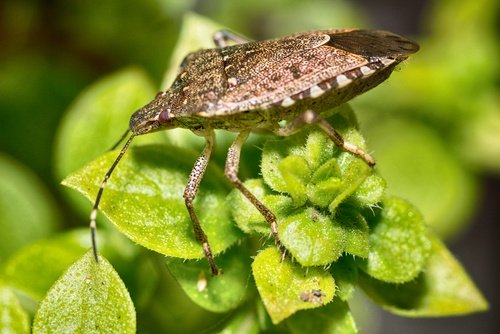- By CycreekPestAdmin
- In General
- Tags General
Increasing in number over the past few decades, stink bugs have become more popular and well-known—or possibly “infamous”. From the pentatomidae family of pests, stink bugs are a mottled brown color with dark bands on their front wings. Their shape appears much like a shield and their size ranges between 12 and 17 millimeters long.
Brown marmorated stink bugs are the most common type of stink bug and these little critters are drawn to warmth and light. In their search for warmth, stink bugs like to hang out on exterior walls of buildings in a sunbathing bunch, which is where they are often noticed first.
Porch lights attract stink bugs to your home when it is dark outside and from there they search for nearby entry points into your warm home. The flat body shape of a stink bug means that they can slip into your home or other buildings through the tiniest cracks and crevices, holes in screens or other unprotected entry points.
When the weather begins to get cold, stink bugs will try to get inside for the winter. They like to spend their winter days and nights hiding inside the walls of your home, in your crawl space or attic. Stink bugs become more active in the spring as they begin think about heading outside. This may be a time when a full infestation becomes more noticeable.
Stink bugs are a nuisance to ornamental plants, gardens and fruit trees. But for people, they are simply unappealing and annoying, rather than actually posing a threat. The smell of stink bugs after they die is not pleasant, requiring time and effort for cleanup. Also their tendency to flock together on ceilings and walls can be unpleasant and annoying. Otherwise, these pests really aren’t harmful as they do not carry disease or cause structural damage to the home.
See Also: 5 Pest Infestations to Watch For This Winter
Don’t Squish Them!
The name says it all: Stink Bug. As a defense mechanism, these smelly critters release an odor when they are crushed or smashed. Not only that, but the foul smell that stink bugs give off contains a chemical that attracts other stink bugs to them. So the last thing you should do is squish them in order to get them out of your home!
Stink Bug Control
Of course, before you get a stink bug infestation is the best time for treatment. Tactics for keeping stink bugs out are similar to preventing other pest infestations. Seal up cracks and crevices around the doors, windows, and foundation of your home. Seal up any entry points in siding, behind chimneys, underneath wood fascia, and around utility pipes. Place screens on roof and gable vents to help prevent stink bugs from entering your home through the attic. As stink bugs tend to enter homes before winter, autumn is the perfect time to schedule an exterior treatment around your house by a pest control professional.
If you happen to find a random stink bug on its own, avoid smashing it. Instead, use a vacuum cleaner to help you remove it—whether alive or dead. But be sure to empty your vacuum cleaner bag right away to keep the smell out of your home and keep the scent from acting as a draw to other stink bugs.
If you have more than one or two random stink bug and suspect that you have an infestation, contacting a pest control professional is ideal. For Houston pest control assistance, contact Cypress Creek to schedule an inspection or become part of our Healthy House program for all of your pest control needs.



